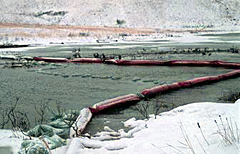NOS Expertise | Restoring Injured Natural Resources
 |
|
|
National Ocean Service scientists respond to oil spills in the USA and abroad, such as this one in northwest Spain caused by the breakup of the tanker Prestige.
|
 |
|
Thousands of incidents occur each year in which oil or chemicals are released into the coastal environment. Spills into our coastal waters, whether accidental or intentional, can harm people and the environment, and can have severe economic impacts, including substantial disruption of navigable waterways.
NOAA’s National Ocean Service (NOS) performs response, assessment and restoration activities for oil and chemical spills under the authority of the Clean Water Act (CWA), the Comprehensive Environmental Response, Compensation and Liability Act of 1990 (CERCLA), the Emergency Planning and Community Right-to-Know Act of 1986 and the Oil Pollution Act of 1990 (OPA). The National Oil and Hazardous Substances Pollution Contingency Plan (NCP) identifies the Department of Commerce as the primary federal trustee for protecting and restoring coastal resources under the CWA, CERCLA, and OPA. The NCP also describes NOAA’s role in providing scientific support for participating in domestic and international planning and response activities.
NOS Expertise
NOS’s Office of Response and Restoration (OR&R) provides scientific expertise for successful incident response and restoration, helping to reduce harm to people, the environment and the economy. NOS scientists are experts in oceanography, biology, economics, ocean modeling, chemistry and geology. Regional NOAA Scientific Support Coordinators organize NOAA resources in support of federal and state response efforts, and work with scientists from other public agencies, academia, and the private sector to support operations when an oil or chemical spill occurs.
 |
|
|
Booms like these collect and trap oil to prevent it from reaching the shoreline.
|
 |
|
A primary task of NOS scientists is to develop and use a variety of modeling software to forecast where the spill might go and its potential effects on the coastal environment.
To help in planning and responding to spills, NOS scientists have created environmental sensitivity index (ESI) maps. These maps are created to serve as quick reference guides to the characteristics and uses of a shoreline. First responders also have access to numerous other tools and information provided by NOS scientists. These include job aids for use during oil spills and chemical spills to determine amounts of oil spilled and best response guidelines. Specific aids have been created for sensitive habitats such as coral reefs as well.
Restoring Injured Natural Resources
 |
|
|
A marsh oiled by a pipeline spill. Black on green is oil on marsh grass. The white stripes lining the waterways are booms. An oil sheen is visible on the water's surface.
|
 |
|
NOS is responsible for assessing damage to coastal and marine resources caused by oil and chemical spills. Through a process known as natural resource damage assessment, NOS scientists determine the nature and extent of injuries to natural resources from spills, and the restoration actions needed to reverse these losses. NOS experts also use scientific and economic studies to determine the level of restoration necessary to restore the natural resources and services they provide. The Damage Assessment and Restoration Program, which is a collaborative effort among NOS, NOAA's National Marine Fisheries Service and the Office of General Council, fulfills NOAA's natural resources damage assessment responsibilities.



